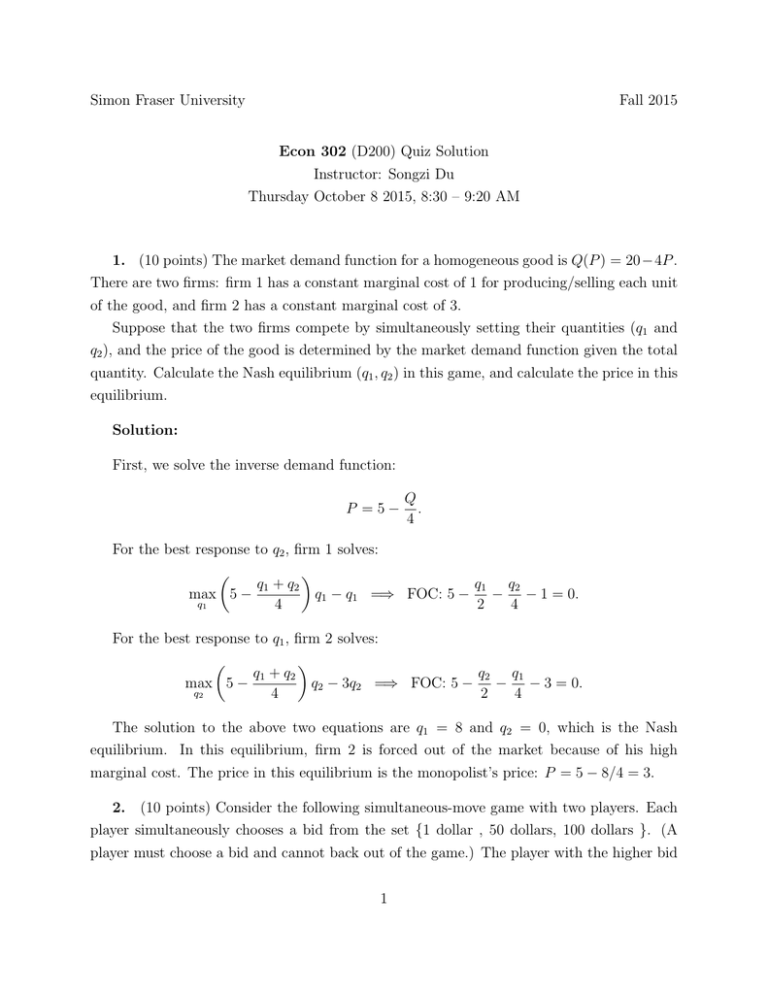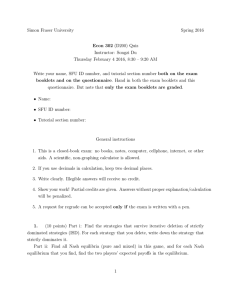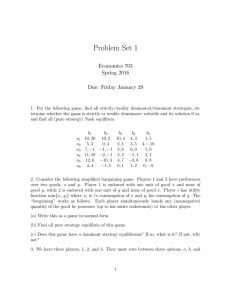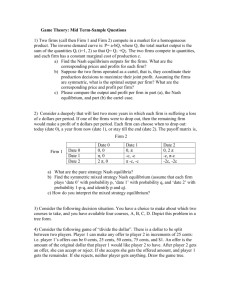Simon Fraser University Fall 2015 Econ 302 (D200) Quiz Solution Instructor: Songzi Du
advertisement

Simon Fraser University
Fall 2015
Econ 302 (D200) Quiz Solution
Instructor: Songzi Du
Thursday October 8 2015, 8:30 – 9:20 AM
1. (10 points) The market demand function for a homogeneous good is Q(P ) = 20−4P .
There are two firms: firm 1 has a constant marginal cost of 1 for producing/selling each unit
of the good, and firm 2 has a constant marginal cost of 3.
Suppose that the two firms compete by simultaneously setting their quantities (q1 and
q2 ), and the price of the good is determined by the market demand function given the total
quantity. Calculate the Nash equilibrium (q1 , q2 ) in this game, and calculate the price in this
equilibrium.
Solution:
First, we solve the inverse demand function:
P =5−
Q
.
4
For the best response to q2 , firm 1 solves:
q1 + q2
q1 q 2
max 5 −
q1 − q1 =⇒ FOC: 5 − − − 1 = 0.
q1
4
2
4
For the best response to q1 , firm 2 solves:
q1 + q2
q 2 q1
max 5 −
q2 − 3q2 =⇒ FOC: 5 − − − 3 = 0.
q2
4
2
4
The solution to the above two equations are q1 = 8 and q2 = 0, which is the Nash
equilibrium. In this equilibrium, firm 2 is forced out of the market because of his high
marginal cost. The price in this equilibrium is the monopolist’s price: P = 5 − 8/4 = 3.
2. (10 points) Consider the following simultaneous-move game with two players. Each
player simultaneously chooses a bid from the set {1 dollar , 50 dollars, 100 dollars }. (A
player must choose a bid and cannot back out of the game.) The player with the higher bid
1
wins a prize of 100 dollars; the other player (the loser) does not receive any prize. If the
two bids are the same, neither player receives the prize. Each player must pay his own bid,
whether or not he wins the prize. (The loser pays too.) The payoff/utility of each player is
simply his net winnings. For example, if player 1 bids 100 and player 2 bids 50, then player
1 gets 100 − 100 = 0 and player 2 gets 0 − 50 = −50; if player 1 bids 50 and player 2 bids
50, then each gets 0 − 50 = −50.
(i) Write the normal form (matrix) of this game.
(ii) Calculate a symmetric mixed strategy Nash equilibrium.
Solution:
Part (i):
The normal form is
$1
$50
$100
$1 −1, −1
−1, 50
−1, 0
$50 50, −1 −50, −50
−50, 0
$100 0, −1
0, −50
−100, −100
Part(ii):
Let us solve for the symmetric mixed-strategy Nash equilibrium. Suppose that each
player bids $1 with probability p, $50 with probability q, and $100 with probability 1 − p − q.
To have incentive to use this mixed strategy, each player must be indifferent between the
three actions if he believes that the other player is following this mixed strategy.
Thus, we have two conditions for this symmetric equilibrium:
(−1)p + (−1)q + (−1)(1 − p − q) = 50p + (−50)q + (−50)(1 − p − q)
{z
} |
{z
}
|
payoff from $1
payoff from $50
(0)p + (0)q + (−100)(1 − p − q) = 50p + (−50)q + (−50)(1 − p − q)
|
{z
} |
{z
}
payoff from $100
payoff from $50
Solving these equations gives:
49
1
,q = .
100
2
In summary, the symmetric mixed-strategy Nash equilibrium is bidding $1 with probability 49/100, bidding $50 with probability 1/2, and bidding $100 with probability 1/100.
p=
3.
(10 points) In Burnaby Mountain there is nothing to do at night but look at the
2
stars or go to the local bar. Let us define the utility of looking at stars as 0, and let the cost
of walking to the bar be 1. Suppose that the utility from being at the bar is 2 (so the net
utility is 2 − 1 = 1) if there are fewer than 3 people (including oneself) at the bar, and 1/2
(the net utility is 1/2 − 1 = −1/2) if there are 3 or more people (including oneself) at the
bar. Suppose that there are only 3 people in Burnaby Mountain at night, and they make
decisions (looking at stars or going to the bar) simultaneously.
(i) Find the three pure-strategy Nash equilibria.
(ii) Calculate the symmetric mixed-strategy Nash equilibrium. And calculate the utility
of each player in this equilibrium.
Solution:
Part (i):
There are three pure-strategy Nash equilibria: one of the three people looks at the star,
the other two go to the local bar.
Part (ii):
Consider a symmetric mixed-strategy Nash equilibrium in which each person goes to the
bar with probability p. One gets 0 from looking at the stars. Assumes that others play the
mixed strategy, by going to the bar one gets −1/2 with probability p2 (the others are all at
the bar), and gets 1 with probability 1 − p2 . Thus, the condition for this mixed strategy to
be an equilibrium is:
1
0 = − p2 + (1 − p2 ).
2
Solving this equation gives:
r
p=
√
2
6
=
≈ 0.82.
3
3
In summary, the symmetric mixed-strategy Nash equilibrium is that each person goes to
√
the bar with probability 36 . By construction, each person is indifferent between looking at
the stars and going to the bar in this equilibrium, thus he gets an expected utility of 0 in
the equilibrium, since looking at the stars gives 0 utility.
3








